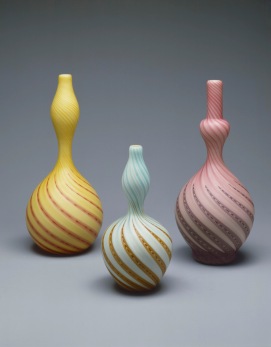Stevens and Williams was an English glass company that was named as such from 1847 to 1967(it is now known as Royal Brierley). Since this rather long period of time, the company has seen enumerable changes in creative direction as well as the name of the company itself.
The Stevens and Williams Glass Company initially made plain, cut crystal glass and colored glass for stained glass windows. In the 1870s, the company saw a significant change in creation when they started making cameo glass. During this time Stevens and Williams were widely known as pioneers and leaders in the industry. Two of the foremost artistic leaders at Stevens and Williams were John Northwood and Frederick Carder.
John Northwood was a technical innovator who is arguably one of the forefathers of British cameo glass. He worked to recreate ancient Greco-Roman aesthetics and frequently used ancient motifs in his pieces. Occasionally, he produced precise replicas of original pieces of Greco-Roman cameo glass.
During his tenure at Stevens and Williams, Frederick Carder—who was mentored by Northwood—often cited the influence of Japanese art and the Art Nouveau movement in his glass masterpieces. He experimented with formulas to create new types of glass, and travelled the world to learn new techniques from other masters and find inspiration for his later designs. Eventually, Carter left the company in 1903 for America, where he founded Steuben Glass Works, thus marking another significant shift in the time of Stevens and Williams.

At the turn of the century, consumer demands changed as tastes shifted from Victorian to more Art Deco styles. There was a need for attractive—yet functional—mass-produced glassware and local glassworks found tough competition with the influx of foreign produced glass. As a result, Stevens and Williams returned to producing less ornate glassware. The decorative arts experienced a decline in productivity during the World War One, but in 1919 Stevens and Williams were awarded a Royal Warrant for their efforts, which meant they supplied glass to the royal family. With the onset of the Second World War, the company started making glass for the military. After the war, the factory was rebuilt and the furnaces updated.
In light of all the triumphs, struggles, changes, and constants, the Stevens and Williams Glass Company shows the strength and longevity in the decorative arts.
Written by Laura Short